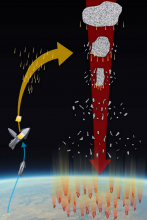Listen to today's episode of StarDate on the web the same day it airs in high-quality streaming audio without any extra ads or announcements. Choose a $8 one-month pass, or listen every day for a year for just $30.
You are here
More Moon and Mars
The gibbous Moon has a famous companion tonight — the planet Mars. It’s to the lower right of the Moon as they climb into good view, around midnight, and almost directly below the Moon at first light tomorrow. Mars looks like a bright orange star.
Mars has two moons of its own. They’re nowhere near as impressive as our moon — Phobos is only about 14 miles in diameter, with Deimos just about half that. Yet they may have something in common with the Moon — the way they were born.
Our moon probably was born after the young Earth was hit by another planet. The impact blasted debris into orbit around Earth. Some of that material coalesced to form the Moon.
Phobos and Deimos might have formed as the result of a big impact as well. A recent study at the Southwest Research Institute says the impactor probably was a few hundred miles in diameter. That’s a good bit smaller than suggested by earlier research.
The collision would have blasted a ring of material into orbit. Some of the material that was close to Mars formed fairly large moons. They were so close, though, that Martian gravity quickly pulled them back down. Some of the debris farther from Mars formed Phobos and Deimos, which are still around today.
The new study says the moons should be made of almost the same material as Mars, with one big exception: The heat of the impact should have vaporized any water. So as Phobos and Deimos coalesced, they were left high and dry.






